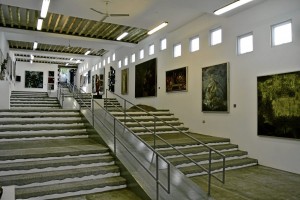
To get there you have go off the main road and drive along one of those typical narrow, winding Antipolo roads, until (after paying a P20 fee to enter the subdivision) you get to the door which is unmistakable as it is simple.
The small but not inconspicuous entrance marks your arrival, welcomes, and leads you off the sidewalk and into Pintô Gallery.
“Pintô” is Tagalog for “door,” and true to its name, the gallery considers itself the “threshold open to all forms of contemporary art experiences.”
However, though the threshold lie experiences that go beyond art.
Instead of walking straight into galleries of artworks from the entrance, you walk into a series of loggias that open to what appears to be a residential, tropical hillside garden with a fabulous view of Manila in the distance.
That is precisely the charm of the place: Its residential feel; the way the structures relate perfectly to the terrain and landscape; and the way the architecture and landscape work so well
together to frame those city views that can only be seen from the Antipolo hills.
Stunning art
Stunning is the art at Pintô. Works of leading Filipino artists are shown with work by young artists encouraged by the gallery through a program of interactions, internships and group exhibitions that seek to nurture and introduce new talent.
Equally stunning is ambiance that the art shares with architecture and landscape, a combination that totally rounds off the experience.
The architecture evokes the picturesque California Mission style, a genre of architecture soft to the Filipino eye and psyche because of shared Spanish colonial references, like arched doorways and windows; squat church-like structures with attached bell towers trimmed with terra-cotta roof tiles.
Making the visual and emotional connection with the Filipino is the extensive reuse of Philippine antique architectural details from the Spanish colonial era incorporated into the California Mission architecture.
Ornate colonial grillwork recycled from endangered bahay-na-bato is re-used as doors and gates. Old lumber holds up some ceilings and are shown as exposed trusses and roof frames.
Hand-carved stone capitals and columns and antique architectural details are mixed into the new architecture.
Whitewashed structures, all recently constructed to look deceivingly like a group of houses built at different levels in response to the natural slope of the terrain, evoke hill towns where houses picturesquely cascade down a hill.
Magnificent garden
Linking all of the multilevel structures of the Pintô hill town is a magnificent tropical garden, properly lush and green, with pathways meandering through intimate sculpture courtyards. View decks on roof terraces and outdoor seating areas are set amid stretches of sloping lawn.
The cavernous galleries, whose high ceilings and floors which step down many levels, so conducive for hanging large-scale art pieces, are not the enclosed “white-box” galleries associated with art venues that display art simply for art’s sake.
Art is displayed at Pintô with the surroundings in mind. Viewers engage with the art through multilevel gallery areas which admit natural light and landscaping, always integrating art
with people and the surrounding environment instead of isolating art, museum-like, from reality.
In many ways, the galleries at Pintô humanize the rarified aura wrongly associated with art. Works of art are not to be locked up in ivory-tower locations but to be enjoyed as pieces that enrich our daily lives.
Something special
At Pintô, high art becomes understandable because of its surroundings but everyday surroundings, the architecture and landscaping, are elevated to something special because of the high art that is a part of the environment.
That is the quality which sets Pintô apart from other galleries.
Despite gallery owner and patron Dr. Joven Cuanang’s repeated invitations to come to Pintô, it took me an age to finally get there for a visit.
Luck would have it that he was not there the day I went.
His having been there would have made the visit more memorable.
Despite his absence, the environment he has created for Pintô speaks for itself, a place where he shares with his visitors a rare experience of peace amid carefully designed surroundings which set off a collection of even more carefully curated art.
Certainly it is an experience worth having, if only to have a short respite from the grind that Manila life can be.
Pintô Art Gallery is at 1 Sierra Madre St., Grand Heights, Antipolo. It is open 9 a.m.-6 p.m., Wednesday-Sunday. E-mail info@pintoartgallery.com.
E-mail the author at pride.place@gmail.com.